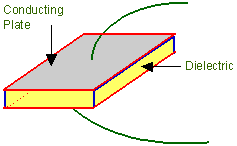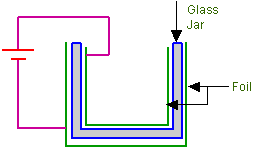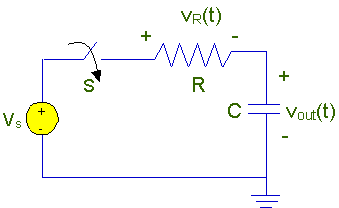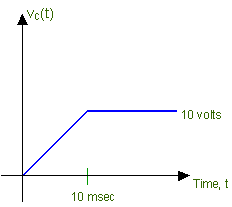Why Are
Capacitors Important?
The
capacitor is a widely used electrical component. It has several features
that make it useful and important:
l
A capacitor can store energy, so capacitors
are often
found in power supplies.
l
A capacitor has a voltage that is proportional
to the charge
(the integral of the current) that
is stored in
the capacitor, so a capacitor can
be used to
perform interesting computations
in op-amp
circuits, for example.
l
Circuits with capacitors exhibit frequency-
dependent
behavior so that circuits that
amplify
certain frequencies selectively can
be built.
What Is A Capacitor?

Capacitors are two-terminal electrical elements.
Capacitors are essentially two conductors,
usually conduction plates - but any two conductors -
separated by an insulator - a dielectric - with conection wires
connected to the two conducting plates.
Capacitors
occur naturally. On printed circuit boards two wires running parallel to each
other on opposite sides of the board form a capacitor. That's a capacitor that
comes about inadvertently, and we would normally prefer that it not be there.
But, it's there. It has electrical effects, and it will affect your circuit. You
need to understand what it does.
At other
times, you specifically want to use capacitors because of their frequency
dependent behavior. There are lots of situations where we want to design for
some specific frequency dependent behavior. Maybe you want to filter out some
high frequency noise from a lower frequency signal. Maybe you want to filter out
power supply frequencies in a signal running near a 60 Hz line. You're almost
certainly going to use a circuit with a capacitor.
Sometimes
you can use a capacitor to store energy. In a subway car, an insulator at
a track switch may cut off power from the car for a few feet along the line. You
might use a large capacitor to store energy to drive the subway car through the
insulator in the power feed.
Capacitors
are used for all these purposes, and more. In this chapter you're going to start
learning about this important electrical component. Remember capacitors do the
following and more.
-
Store energy
-
Change their behavior with frequency
-
Come about naturally in circuits and
can change a circuit's behavior
GOALS
You
need to know what you should get from this lesson on capacitors. Here's the
story.
lGiven
a capacitor
uBe
able to write and use the voltage-current
relationship for the capacitor,
uBe
able to compute the current through a
capacitor when you know the voltage across
a capacitor.
lGiven
a capacitor that is charged, uBe
able to compute the amount of energy that
is stored in the capacitor.
Capacitors and inductors are both elements that can store energy in
purely electrical forms. These two elements were both invented early in
electrical history. The capacitor appeared first as the legendary Leyden jar, a
device that consisted of a glass jar with metal foil on the inside and outside
of the jar, kind of like the picture below. This schematic/picture shows a
battery attached to leads on the Leyden jar capacitor.
 Although this device first appeared in Leyden, a city in the Netherlands
sometime before 1750. It was discovered by E. G. von Kleist and Pieter van
Musschenbroek. Although it has been around for about 250 years, it has all of
the elements of a modern capacitor, including:
Although this device first appeared in Leyden, a city in the Netherlands
sometime before 1750. It was discovered by E. G. von Kleist and Pieter van
Musschenbroek. Although it has been around for about 250 years, it has all of
the elements of a modern capacitor, including:
-
Two conducting plates. That's the
metallic foil in the Leyden jar.
-
An insulator that separates the
plates so that they make no electrical contact. That's the glass jar - the
Leyden jar.
 The way the Leyden jar operated was that charge could be put onto both foil
elements. If positive charge was put onto the inside foil, and negative charge
on the outside foil, then the two charges would tend to hold each other in
place. Modern capacitors are no different and usually consist of two metallic or
conducting plates that are arranged in a way that permits charge to be bound to
the two plates of the capacitor. A simple physical situation is the one shown at
the right.
The way the Leyden jar operated was that charge could be put onto both foil
elements. If positive charge was put onto the inside foil, and negative charge
on the outside foil, then the two charges would tend to hold each other in
place. Modern capacitors are no different and usually consist of two metallic or
conducting plates that are arranged in a way that permits charge to be bound to
the two plates of the capacitor. A simple physical situation is the one shown at
the right.
If the top
plate contains positive charge, and the bottom plate contains negative charge,
then there is a tendency for the charge to be bound on the capacitor plates
since the positive charge attracts the negative charge (and thereby keeps the
negative charge from flowing out of the capacitor) and in turn, the negative
charge tends to hold the positive charge in place. Once charge gets on the
plates of a capacitor, it will tend to stay there, never moving unless there is
a conductive path that it can take to flow from one plate to the other.
There is also a standard circuit symbol for a capacitor.
The figure below shows a sketch of a physical capacitor, the corresponding
circuit symbol, and the relationship between Q and V. Notice how the symbol for
a capacitor captures the essence of the two plates and the insulating dielectric
between the plates.
 
Now, consider a
capacitor that starts out with no charge on either plate. If the capacitor is
connected to a circuit, then the same charge will flow into one plate as flows
out from the other. The net result will be that the same amount of charge, but
of opposite sign, will be on each plate of the capacitor. That is the usual
situation, and we usually assume that if an amount of charge, Q, is on the
positive plate then -Q is the amount of charge on the negative plate.
The essence of a capacitor is that it stores charge. Because
they store charge they have the properties mentioned earlier - they store energy
and they have frequency dependent behavior. When we examine charge storage in a
capacitor we can understand other aspects of the behavior of capacitors.
In a
capacitor charge can accumulate on the two plates. Normally charge of opposite
polarity accumulates on the two plates, positive on one plate and negative on
the other. It is possible for that charge to stay there. The positive charge on
one plate attracts and holds the negative charge on the other plate. In that
situation the charge can stay there for a long time.
That's it
for this section. You now know pretty much what a capacitor is. What you need to
learn yet is how the capacitor is used in a circuit - what it does when you use
it. That's the topic of the next section. If you can learn that then you can
begin to learn some of the things that you can do with a capacitor. Capacitors
are a very interesting kind of component. Capacitors are one large reason why
electrical engineers have to learn calculus, especially about derivatives.
In the next section you'll learn how capacitors influence voltage and current.
Voltage-Current Relationships In Capacitors
There is a
relationship between the charge on a capacitor and the voltage across the
capacitor. The relationship is simple. For most dielectric/insulating
materials, charge and voltage are linearly related.
 Q
= C V Q
= C V
where:
-
V is the voltage across the plates.
You will need to define a polarity for that voltage. We've
defined the voltage above. You could reverse the "+" and "-".
-
Q is the charge on the plate with
the "+" on the voltage polarity definition.
-
C is a constant
- the capacitance of the capacitor.
The relationship
between the charge on a capacitor and the voltage across the capacitor is linear
with a constant, C, called the capacitance.
Q = C V
When
V is measured in volts, and Q is measured in couloumbs, then C has the units of
farads. Farads are really
coulombs/volt.
The relationship, Q = C V, is the most
important thing you can know about capacitance. There are other details you may
need to know at times, like how the capacitance is constructed, but the way a
capacitor behaves electrically is determined from this one basic relationship.

Shown to the right is a circuit that has a voltage source, Vs, a
resistor, R, and a capacitor, C. If you want to know how this circuit works,
you'll need to apply KCL and KVL to the circuit, and you'll need to know how
voltage and current are related in the capacitor. We have a relationship between
voltage and charge, and we need to work with it to get a voltage current
relationship. We'll look at that in some detail in the next section.
The basic relationship in a capacitor is that the voltage is proportional to the
charge on the "+" plate. However, we need to know how current and voltage are
related. To derive that relationship you need to realize that the
current flowing into the capacitor
is the rate of charge flow
into the capacitor. Here's the situation. We'll start with a capacitor with a
time-varying voltage, v(t), defined across the capacitor, and a time-varying
current, i(t), flowing into the capacitor. The current, i(t), flows into the "+"
terminal taking the "+" terminal using the voltage polarity definition. Using
this definition we have:
ic(t) = C dvc(t)/dt
This
relationship is the fundamental relationship between current and voltage in a
capacitor. It is not a simple proportional relationship like we found for a
resistor. The derivative of voltage that appears in the expression for current
means that we have to deal with calculus and differential equations here -
whether we want to or not.
Q1.
If the voltage across a capacitor is descreasing (and voltage and current are
defined as above) is the current positive of negative?
This
derivative kind of relationship also has some implications for what happens in a
capacitor, and we are going to spend some time exploring that relationship.
Clearly, we need to understand what this relationship implies, and then we need
to learn how it affects things when we write circuit equations using KVL and
KCL.

We'll start by considering a time varying voltage across a capacitor. To have
something specific, let's say that we have a 4.7mf capacitor, and that the
voltage across the capacitor is the voltage time function shown below. That
voltage rises from zero to ten volts in one millisecond, then stays constant at
ten volts. Before you go on try to determine what the current through the
capacitor looks like, then answer these questions.
Q2.
Is the current constant in the time interval from t = 0 to t = 10 msec?
Q3.
Is the current constant in the time interval from t = 10 msec to the last time
shown?
-
If current is proportional
to the time derivative of voltage, there is only
one time segment, from t = 0 to 1 millisecond, where the voltage derivative is
non-zero, so that's the only time there is any
currrent that is non-zero.
-
After one millisecond has
elapsed, the voltage derivative goes to zero, so there isn't any current then.
If there isn't any current, then the voltage stays constant because no charge is
flowing in or out. Remember, current is charge flow!
-
The voltage derivative is
constant from t = 0 to 1 millisecond. If that's true, then the current is
constant in that period.
Now, you
should be able to compute the current.
Energy In Capacitors
Storing energy is very important. You count on the energy stored in your gas
tank if you drove a car to school or work today. That's an obvious case of
energy storage. There are lots of other places where energy is stored. Many of
them are not as obvious as the gas tank in a car. Here are a few.
-
You're reading this on a
computer, and the computer keeps track of the date and time. It does that by
keeping a small part of the computer running when you think that the computer is
turned off. There's a small battery that stores the energy to keep the clock
running when everything else is turned off.
-
If you own a stereo or
television that you have to plug into the wall plug, then you should realize
that the wall plug voltage becomes zero 120 times a second. When that
happens, the system keeps running because there are capacitors inside the system
that store energy to carry you through those periods when the line voltage isn't
large enough to keep things going!
Capacitors can't really be used to store a lot of energy, but there are many
situations in which a capacitor's ability to store energy becomes important. In
this lesson we will discuss how much energy a capacitor can store.
Capacitors are often used to store energy.
-
When relatively small
amounts of energy are needed.
-
Where batteries are not
desired because they might deteriorate.
-
For larger power/short
duration applications - as in power supply filters, or to keep power up long
enough for a computer to shut down gracefully when the line power fails.
To
calculate how much energy is stored in a capacitor, we start by looking at the
basic relationship between voltage and current in a capacitor.
i(t) = C dv(t)/dt

Once we have this relationship, we can calculate the power - the rate of flow of
energy into the capacitor - by multiplying the current flowing through the
capacitor by the voltage across the capacitor.
P(t) = i(t)v(t)
P(t) = i(t)v(t)
i(t) = C dv(t)/dt
P(t) = (C
dv(t)/dt) v(t)
|

